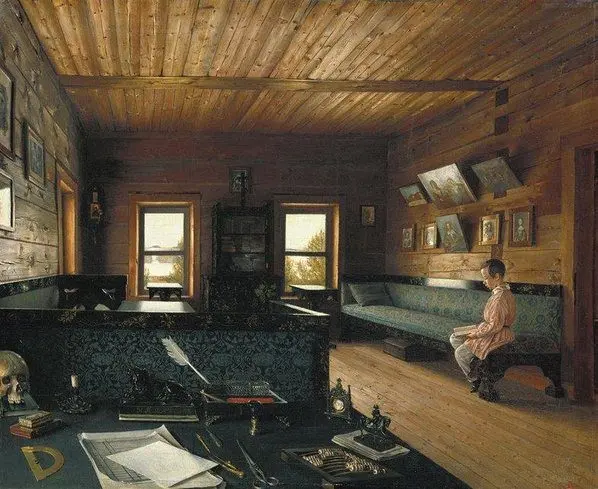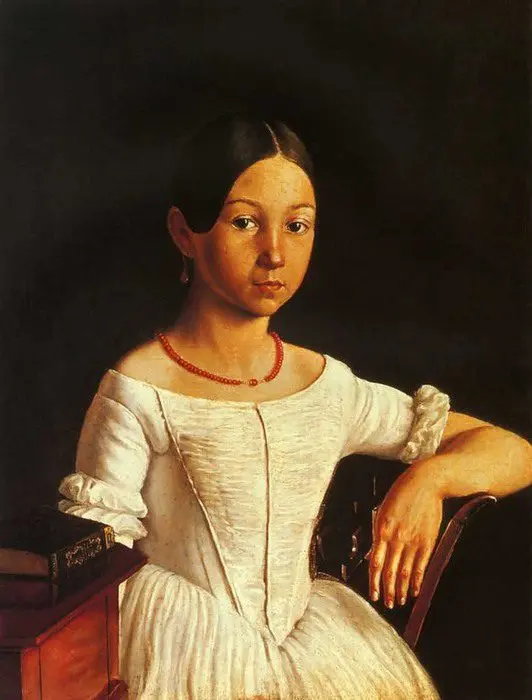🙂 Greetings to art lovers! Grigory Soroka is an outstanding Russian artist, a man of tragic fate. The talented painter left us stunning portraits and landscapes of those times. All of his works have a special charm. See for yourself!
Artist Soroka
The fate of Grigory Soroka (Vasiliev) was typical of his time. “Vasiliev’s son” was born in the Tver province and was a serf of the landowner Nikolai Milyukov. “Magpie” is his nickname.
From childhood, the boy liked to draw. And when the young man turned eighteen, fate presented him with a gift: a meeting with the artist Alexei Gavrilovich Venetsianov. The famous artist lived next door to Milyukov.

Grigory Soroka. Portrait of the artist Alexei Gavrilovich Venetsianov. 1840th
As you know, Venetsianov since the 1820s. organized a painting school on his estate Safonkovo. In his school, he took full support boys from poor families. Many of them (there were about 80 students in total) later formed the well-known “Venetian school”.
From the very first works, the self-taught person showed that he possesses an outstanding talent. His sketches of peasants convinced Venetsianov that the young man was observant and well versed in the character traits of the people he portrayed.

Gregory Soroka “Gumno” 1843
Grigory Soroka loved and respected his teacher very much. It is not for nothing that his first picture, like the first picture of Venetsianov himself, is called “The Barn”. Although it was a kind of student work, it already shows a great love for the native land.
The talented student of Venetsianov never got the opportunity to develop his talent. Despite all the efforts of his teacher, Grigory Soroka remained a serf. This left a tragic imprint on his fate.
Grigory Soroka: paintings
More than other students of the master, Grigory Soroka developed a poetic and at the same time sympathetic and loving view of the world of the Russian peasantry. Such are his pencil portraits of peasants, such is his “Threshing floor”.
The landscapes created by the young artist are considered one of the best in the genre. The landscapes are full of serenity and lyricism. They are painted with such love that it seems that the artist saw harmony, harmony and peace in this landscape.
Soroka owns one of the best Venetian interiors “Cabinet in the Ostrovki estate”, with a magnificent still life on the writing table. Most successfully painted are smoothly planed log walls, on which soft daylight glides.

“Study in the estate Ostrovki”, 1844
This light is used with a unique skill to characterize not only the space, but also the texture of objects. On the lacquered surface of wooden furniture, it lays down with light reflections.
It lies softly, broadly on the even floorboards of the unpainted floor, crushes on the glass of the portraits on the wall, illuminates the picturesque unglazed pictures more evenly. And the boy, with a book in his hands (for some reason it seems that this is a volume of poetry), crouched on the edge of the sofa, as if the personification of some elusive elegance and delicacy.

Portrait of Lydia Nikolaevna Milyukova. Second half of the 1840s
As a court painter, Soroka also painted the children of his master: Elizabeth and Lydia Milyukov. Portraits of children, for some reason, resemble the work of the masters of the Renaissance. There is so much inner enlightenment in them, faith in the human soul.
The accuracy of the characterization of “dead nature”, devoid, however, of the dryness and illusory nature of naturalism, is also inherent in GV Soroka’s still life “Reflection in the Mirror”. Here, the everyday nature of the selection of things is organically combined with a genre scene reflected by a mirror.

“Reflection in the Mirror” 1850s
Among the surprisingly lyrical paintings, his “Self-portrait”, written in 1841-1842, stands apart. Although the artist portrayed himself outwardly calm, his eyes speak of suffering and insecurity from fate and life circumstances (Image in miniature for the article)
Landscapes
Most of the artist’s landscapes show the surroundings of Lake Moldino. “Fishermen”, “View of the dam in the estate”, “View of Lake Moldino” are uncomplicated in the chosen motive. In all three works, the authenticity of the observation of nature is striking, organically merged with some kind of heightened sense of its beauty.

“Fishermen” Second half of 1840

“Type of Lake Moldino”, 1840s

View of the dam in the Spasskoye estate in the Tambov province. 1840th
The feeling of silence, poured out in motionless groves, in the frozen surface of the lake, in a high sky devoid of clouds, is perfectly conveyed. This is a feeling of silence and even somewhat exaggerated peace. It is also felt in the figures of fishermen, mowers in white shirts and high bright hats, women in loose dresses.
Their movements are slow, the folds of their clothes are simple and straight. In these canvases, there is no that picturesque vibration of color and the melting of the contour in the deep planes that Venetsianov himself has.
The landscapes of Grigory Vasilyevich Soroka seem to be devoid of air. The distinctness with which this whole beautiful world opens up to the eye bears the imprint of some nagging, sad acuteness – an individual feature of the artist’s works.
last years of life
Fate was really strict in relation to the artist, and at times merciless. Despite Venetsianov’s attempts to “ask for freedom for him,” Soroka remained a serf until the last days of his life. Miliukov refused him “free”, forbade him to travel to St. Petersburg, forced him to take care of the garden.
Soon (1847) Venetsianov died, and the life of Grigory Soroka turned into a slow extinction. Forced marriage without love to a serf oppressed him. He lived in the village, painted images for the church, sometimes taught the boys to draw.
In 1861 Soroka was arrested and subjected to corporal punishment for a sharp speech against his master. After some time, he was released “due to illness,” but something broke in him. In May 1864, his body was found “hanging in a burning hut”.
This is how one of the remarkable “praises” of Russian life and nature, Grigory Soroka, passed away. He was only 40 years old (1823-1864). Let me remind readers: in 1861 serfdom was abolished in Russia, in fact – slavery.
Video
Unfortunately, there are not enough video materials about Grigory Soroka. This video contains additional and informative information about the artist and his paintings.
😉 Friends, leave in the comments to the article. Did you know the artist Grigory Soroka before? Share this information on social media. Check out this site for new stories!









